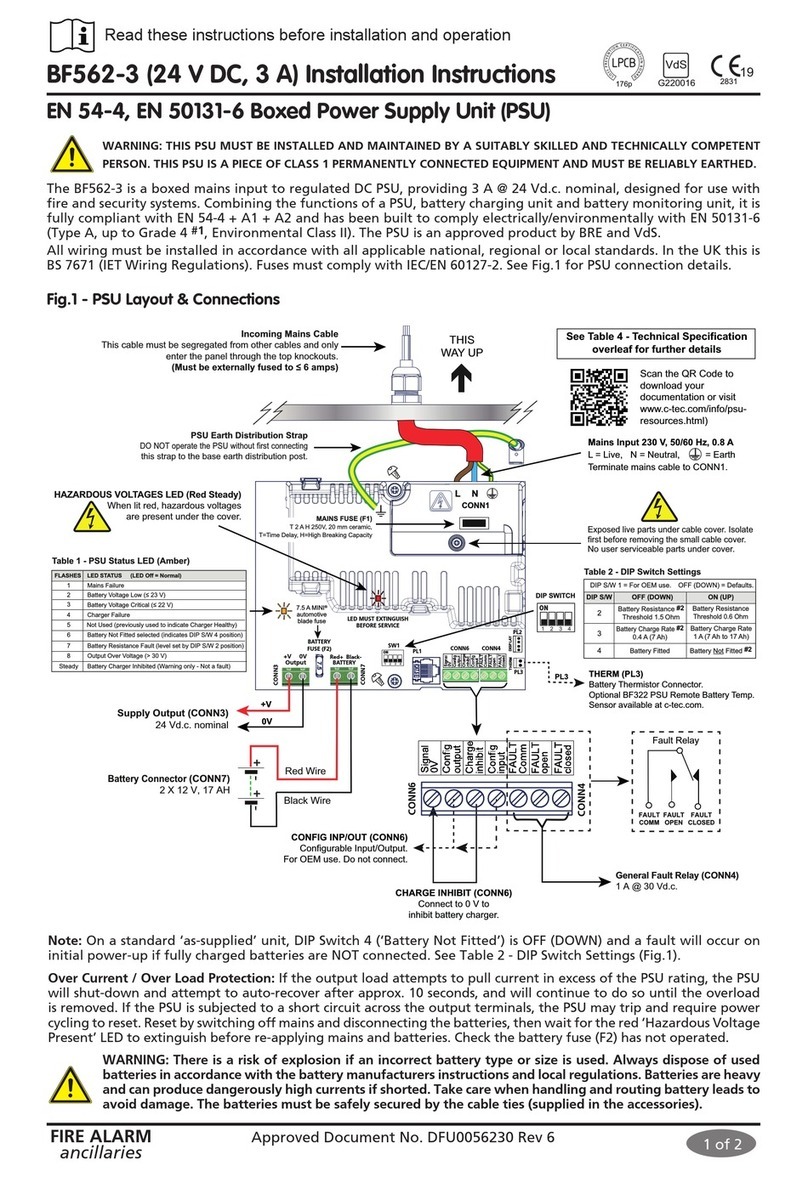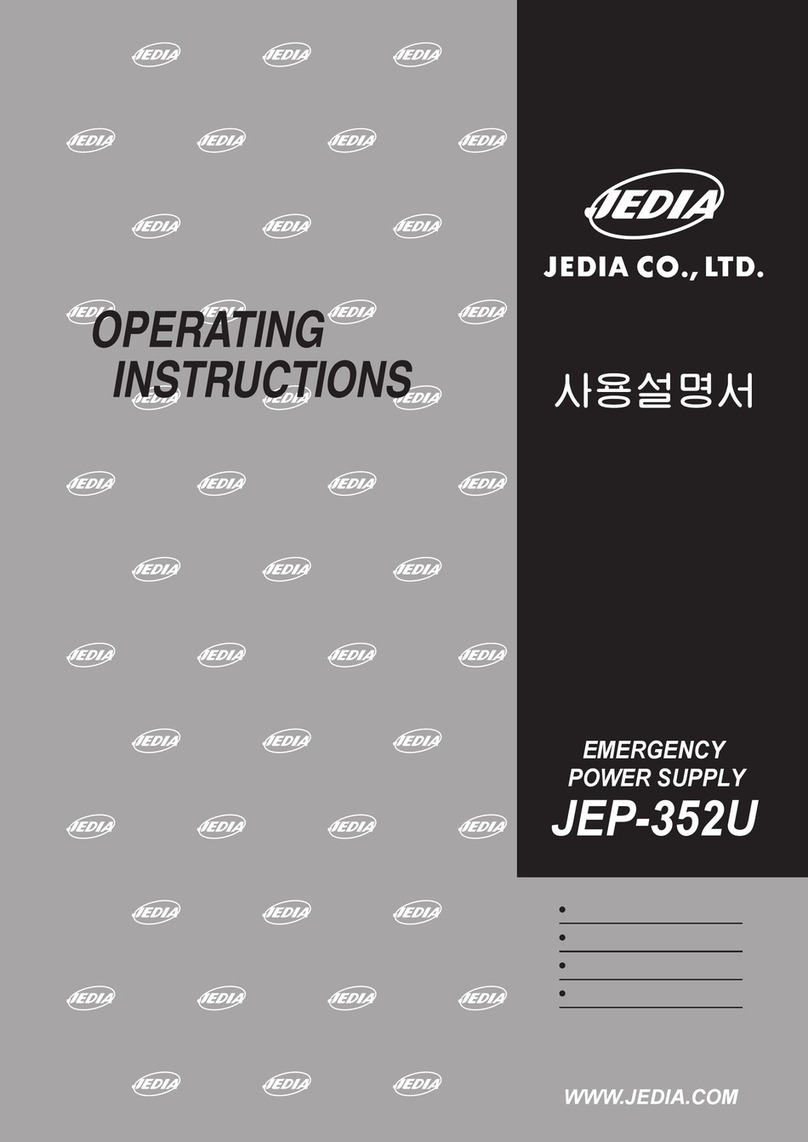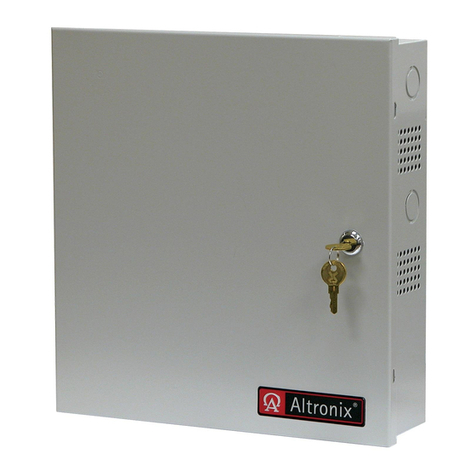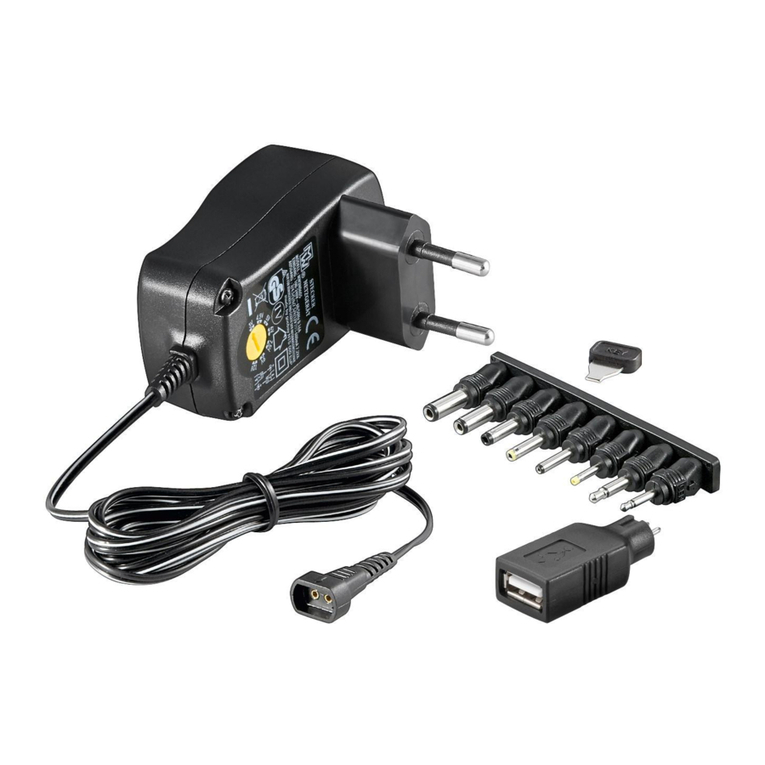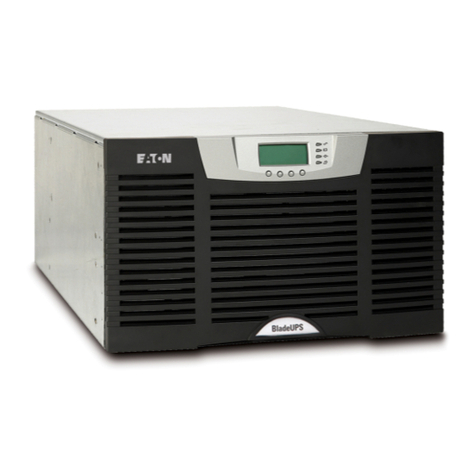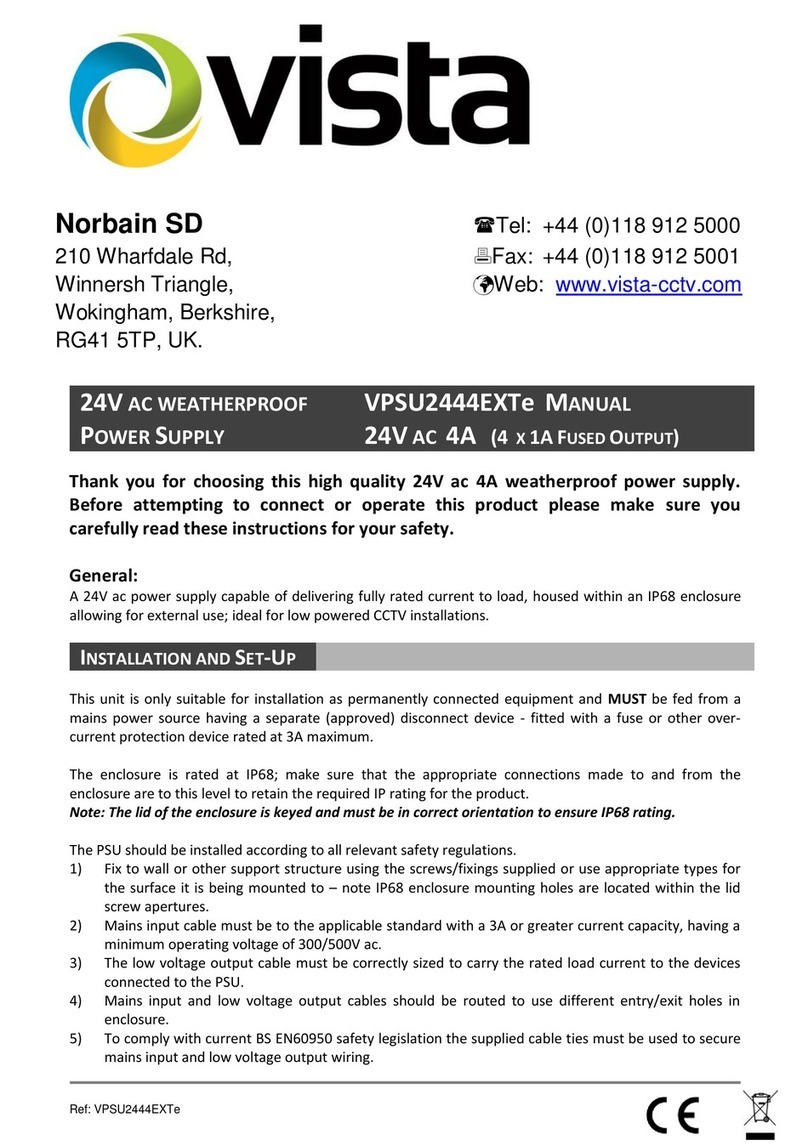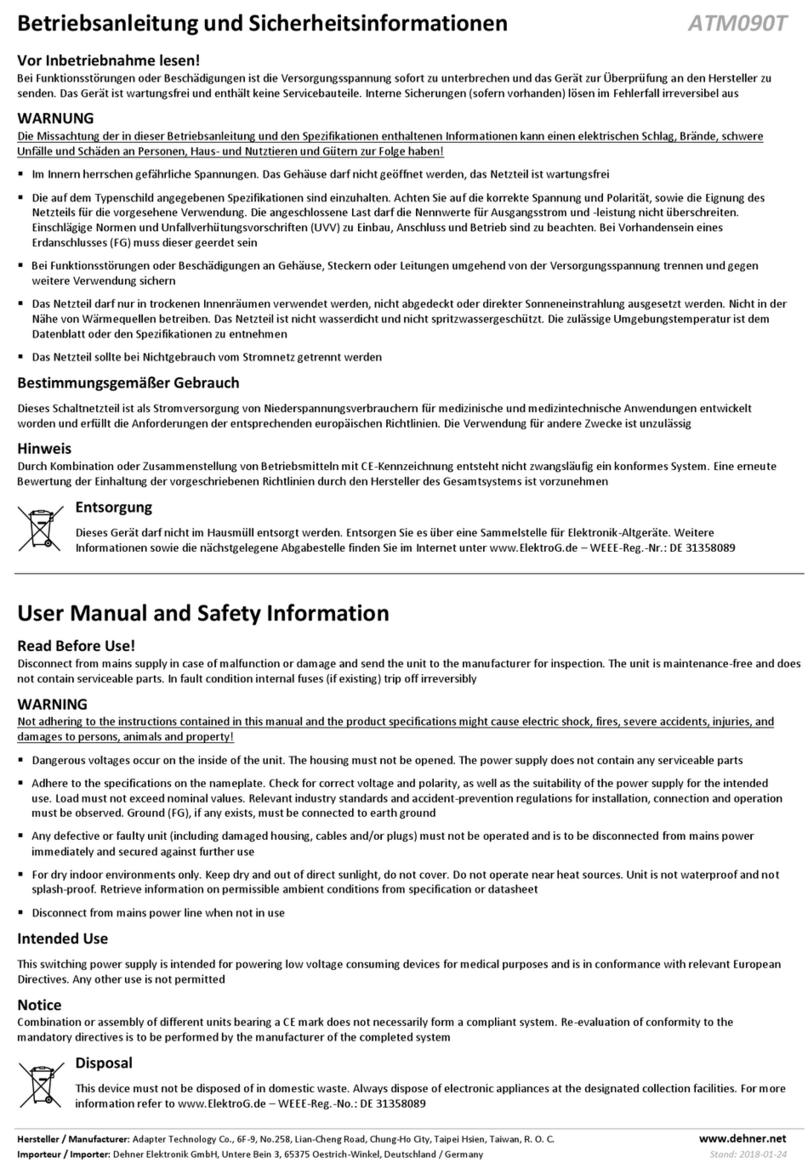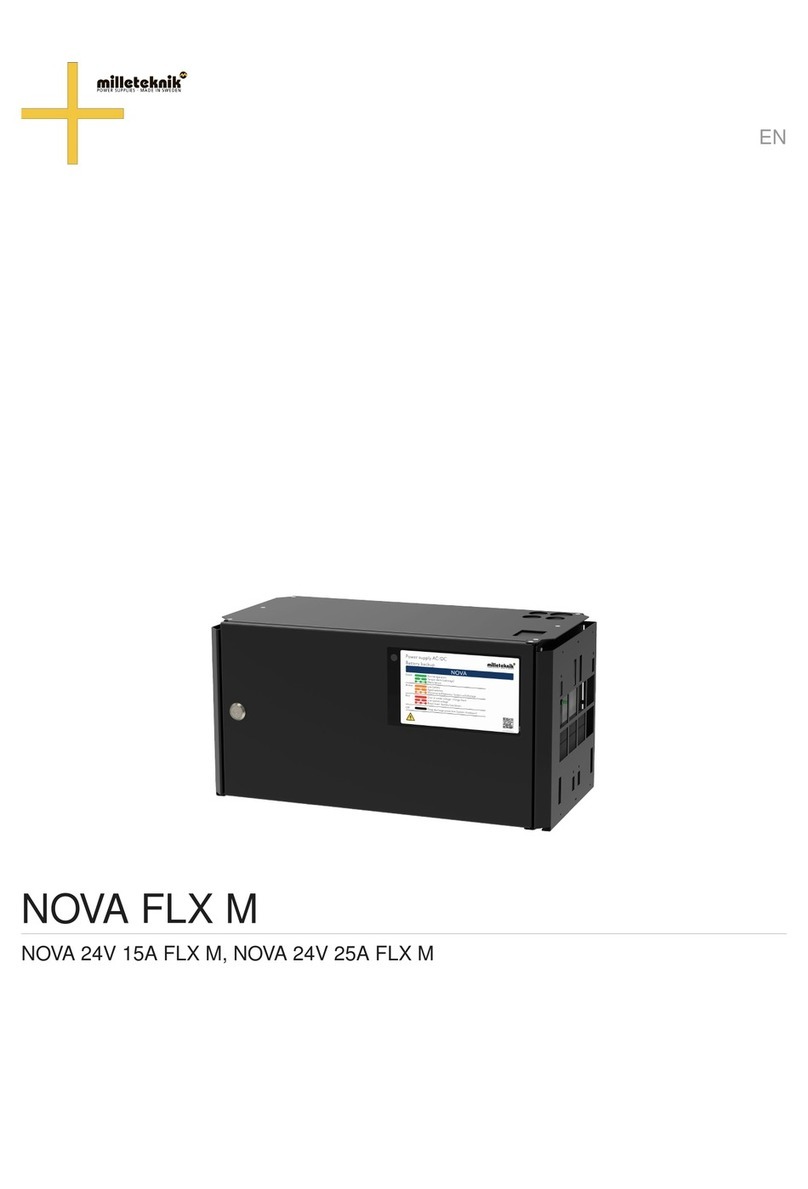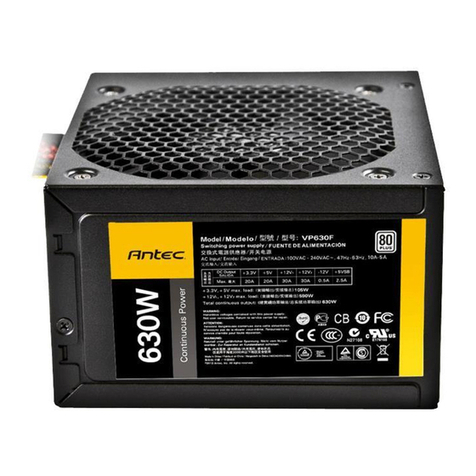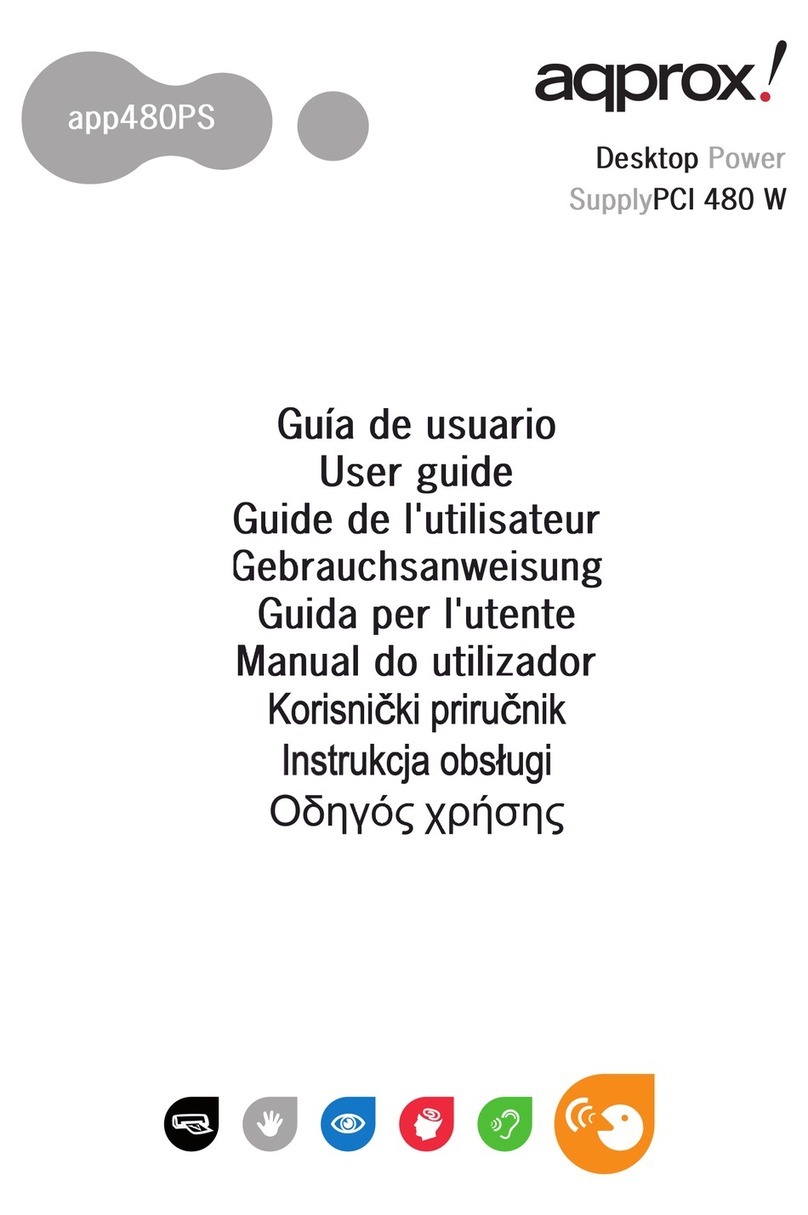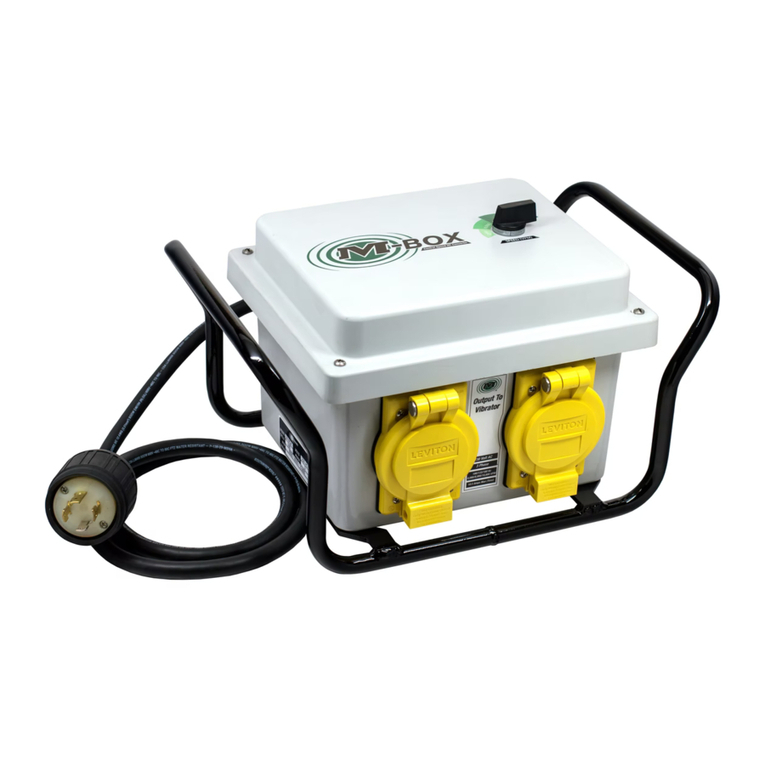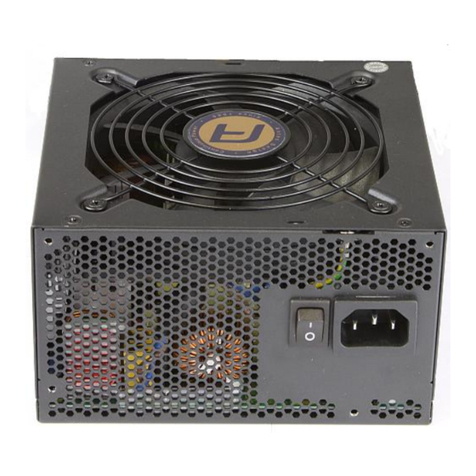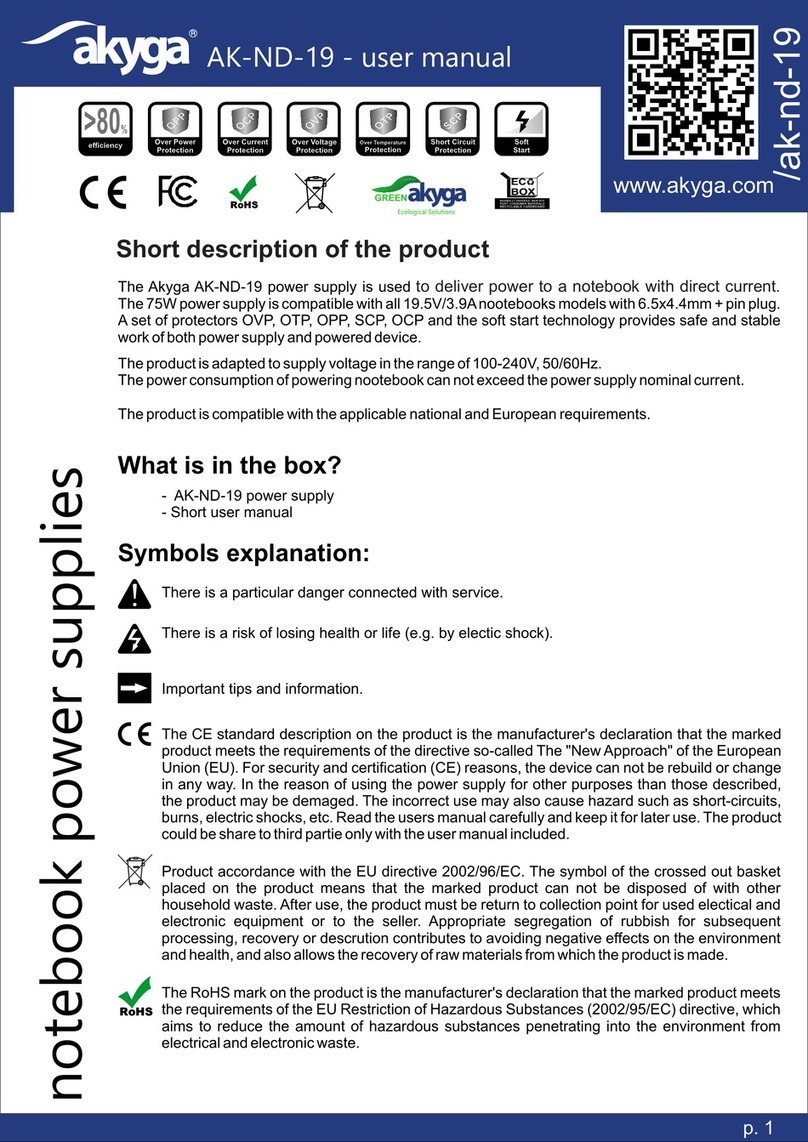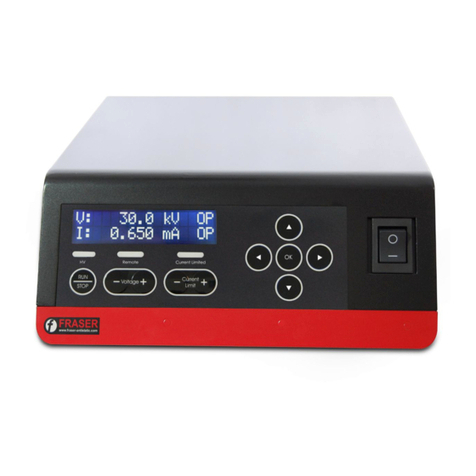Strong International XENON User manual

STRONG INTERNATIONAL
adivisionofBallantyneofOmaha,Inc.
4350 McKinley Street
Omaha, Nebraska 68112 USA
Tel 402/453-4444 • Fax 402/453-7238
www.strongint.com
XENON POWER SUPPLY
for 10 kW Britelight Lamphead
Rev. June 2004

CONTENTS
Page
PREFACE .............................................. 1
INSTALLATION ................................... 1
Tap Adjustment................................ 2
INSTALLATION DIAGRAM ............... 5
TROUBLESHOOTING ........................ 6
MAINTENANCE .................................. 9
WIRING DIAGRAM ............................ 10
PARTS ILLUSTRATIONS
Figure 1............................................ 11
Figure 2............................................ 13
Figure 3............................................ 14

PREFACE
THIS XENON POWER SUPPLY manufactured by Strong International is a dual-
chassis, high reactance 10,000 watt unit utilizing silicon diodes as the power conversion elements. All
models are designed for 50/60 Hertz operation, and are available in varyingAC input types, depend-
ing upon the configuration of the main power transformers. Check the Equipment Data Plate to
determine the exactAC requirement prior to installation.
COARSE AND FINE TAPS are easily set to regulate the DC current to the xenon
bulb. Some models of this power supplies have the capability of overdriving a xenon bulb; carefully
check the power requirements specified by the bulb manufacturer and do not exceed the maximum
current stated.
DC OUTPUT to the xenon bulb is filtered by means of filter capacitors. A relay-
operated resistor circuit reduces the inrush current upon ignition to prolong bulb life. Suppression
capacitors prevent RF interference.
OVERSIZE HEAT SINKS disperse the heat normally generated by the silicon diodes.
Eachpower supplychassisinclude aninternally wired blower for additionalheat dissipation. Thermal
switches on the rectifier heat sinks act as safety interlocks to shut down the power supply and protect
the rectifier diodes in case temperatures reach excessive levels.
INSTALLATION
CHECK THE EQUIPMENT DATA PLATE and make certain that the AC source
conforms to the power requirements of the main power transformers. See the Installation Diagram
on Page 5 for detailed AC hook-up, line protection, and lamp connections. The AC service wiring
shouldbe installed by a licensedelectrician inconformance tolocal codes. The unit must beconnected
to an adequate earth ground.
THE AC LINE to the xenon power supply must include a marked line safety switch
or other power disconnect device adjacent to the unit and accessible to the operator. For operator
safety, it is necessary to turn off all power to the unit when adjusting or servicing the xenon power
supply. This safety switch or power disconnect should be tagged “OFF - UNITUNDER REPAIR”
when the power supply is being serviced.
1

INSTALLATION (continued)
OBSERVING ALL SAFETY PROCEDURES, install a xenon bulb of the desired
wattage into the lamphouse. Check the bulb manufacturer’s documentation to confirm the recom-
mended current range of the 10 kW bulb (165-210 amperes DC). A new bulb is normally first oper-
ated at “nominal” current, which is around 85% of the maximum level (180 A.). DO NOT, at any
time, exceed the maximum current level specified by the bulb manufacturer.
IGNITE THE XENON BULB and check the current as indicated on the control
panel ammeter. Allow (30) seconds for the current to stabilize and provide an accurate reading. If
the current is not within the above-noted range, extinguish the bulb. It will be necessary to increase or
decrease the DC output.
OUTPUT CURRENT ADJUSTMENT
WARNING
Turn off ALL primary AC power before making any
adjustments or performing service procedures. Allow
several minutes for the capacitors to drain stored en-
ergy. The power supply normally operates warm to
hot; allow the unit to cool to safe temperature.
2

INSTALLATION (continued)
FINE ADJUSTMENT of the DC current is made to the NUMBERED taps found on the upper
three terminal blocks (TB4, TB5, TB6). Fine taps are numbered 1-2-3-4, with “1” providing the
lowest output, increasing to “4,” yielding the highest output. A “fine” tap adjustment raises or
lowers the current approximately four amperes. The three fine tap terminal blocks are interconnected
by means of a three-lead jumper wire assembly attached to like-numbered terminals.
•Toincrease the DC output, move the jumper wire assembly to tap the next (3) higher numbered
terminals, for example, move from terminals “2” to terminals “3.” ALLTAPS MUST BE ONTHE
SAME NUMBERED POSITION (1-1-1, 2-2-2, 3-3-3, or 4-4-4). If the DC output is still too low
when terminals “4” are interconnected, see the following instructions for adjusting “coarse” taps.
•Todecrease the DC output, move the jumper wire assembly to tap the next (3) lower numbered
terminals, for example, move from terminals “3” to terminals “2.” ALLTAPS MUSTBE ON THE
SAME NUMBERED POSITION (1-1-1, 2-2-2, 3-3-3, or 4-4-4). If the DC output is still too high
when terminals “1” are interconnected, see the following instructions for adjusting “coarse” taps.
COARSE ADJUSTMENT of the DC current is made to the LETTERED taps found on the lower
three terminal blocks (TB1, TB2, TB3). Coarse taps are lettered W-X-Y-Z, with “W” providing the
lowest output, increasing to “Z” at the highest output. The coarse tap terminals connect to contactor
terminals T1, T2, and T3. The (3) contactor leads must connect to the same lettered step (W-W-W,
etc.). A “coarse” tap adjustment raises or lowers the current approximately twelve amperes.
•Toincrease the coarse DC output, move each of the contactor leads to tap the next higher lettered
terminals, for example, move from terminals “W” to terminals “X.” ALL TAPS MUST BE ON
THE SAME LETTERED POSITION (W-W-W, X-X-X, Y-Y-Y, or Z-Z-Z). Place the fine tap
jumper on 1-1-1. Ignite the lamp, check the output, and increase the fine tap setting as required.
•Todecrease the coarse DC output, move each of the contactor leads to tap the next lower lettered
terminals, for example, move from terminals “Y” to terminals “X.” ALL TAPS MUST BE ON
THE SAME LETTERED POSITION (W-W-W, X-X-X, Y-Y-Y, or Z-Z-Z). Place the fine tap
jumper on 1-1-1. Ignite the lamp, check the output, and increase the fine tap setting as required.
NOTE: Balance power supply output; i.e. set power supplies at or near the same output settings:
Power Supply “A” X-X-X, 4-4-4 (or as required)
Power Supply “B” Y-Y-Y, 1-1-1 (or as required)
INSPECT TAP CONNECTIONS to verify that the terminal is clamping the copper
conductor, not the insulation. Make certain all terminal clamping screws are tight.
3

INSTALLATION (continued)
WHENEVER MAKING A COARSE ADJUSTMENT, again check the ammeter
reading and make certain the current is within the desired range. A re-adjustment of the fine taps is
frequently required after changing coarse taps.
OBSERVE CURRENT (AMPERAGE) READING ONLY when setting the output.
The “voltage” reading can vary between individual xenon bulbs, and while wattage can be determined
bymultiplying volts times amperes, itis possibleto overdrive and damage thebulb byoperating it over
210 amperes. The arc voltage reading serves as a troubleshoooting tool detailed later.
REMOTE IGNITION CONTROL is enabled by connecting a dry contact across
Terminals TB3-1 and TB3-2 and placing the REMOTE/LOCAL switch on the control panel to
REMOTE. The lamphead will then ignite only when SYSTEM ON/OFF switch is in the ON posi-
tion and the remote control contact is closed.
AFTERPROLONGED OPERATION,the lightoutput of the xenon bulbwill decrease.
This is a normal factor of bulb aging, and can be compensated by raising the DC output of the xenon
power supply. If the bulb was first operated at “nominal” current, the power supply output can
gradually be increased to, but not in excess of, he maximum current specified by the bulb manufac-
turer. Increase the current as instructed above. Decrease the power supply output to its former
“nominal” current level upon the installation of a new replacement bulb.
TIMER PC BOARD OPERATION
TIMER PRINTED CIRCUIT BOARD ASSEMBLY (Part No. 32-70137) provides
timing functions to lamphead ignition and shutdown. Upon closure of the POWER “ON” switch
(“Local” mode), and assuming all interlocks are closed, Relays K2 and K3 latch and energize the
igniter circuit. The lamphead igniter will discharge and provide a pulsed arc between the electrodes of
thexenon bulb. A functional bulb willnormally igniteafter one or two ofthese pulses. Ifthe bulbdoes
not ignite within a period of one (1) minute, the relays will drop out and de-energize the igniter circuit
to protect the bulb electrodes. In this event, it is necessary to replace the xenon bulb or troubleshoot
the lamphead and power supply system.
THE “STRIKE” SWITCH on the control panel bypasses the above timing function
and provides an immediate ignition pulse assuming the system is “ON” and all interlocks closed.
AFTER EXTINGUISHING THEARC (POWER “OFF” setting), Time-Delay Relay
K4 will actuate and allow the cooling blowers to continue operating for 20 minutes. This measure is
necessary to properly cool the xenon bulb and insure full bulb life. Most xenon bulb manufacturers
will not grant warranty credit on bulbs that are not forced-air cooled after operation.
4

INSTALLATION WIRING DIAGRAM
5
PowerSource
Line
Safety
Switch
Fuse/Breaker
Panel
AC LINE PROTECTION
208/230 V. 380/440 V.
50 A. 25 A.
Lamphead Cable Assembly
P1
SYSTEM MUST BE GROUNDED
All wiring must conform to local
electrical code; shield lamphead
cable in conduit if required.
XENON
POWER
SUPPLY
OBSERVE CORRECT
POLARITY
BRITELIGHT LAMPHEAD
(Connections Prewired)
TB9 Connections:
1 Green
2 Orange
3 Blue
4 Red
5 Black
6 White
7 Brown
8 Yellow
AC Input

TROUBLESHOOTING
POWER LINE PROBLEMS
PRIMARYPOWER(AC source)problems aremost commonly(a) completeloss ofACpower,
or (b) phase loss, in which one phase loses power.
a) Check line safety switch (“ON”). Check fuses or breakers in supply line. Using anAC voltmeter,
measure input power at contactor terminals L1, L2, L3.
b) When power is lost on one phase, the current ripple will increase and trip the AC line circuit
breaker or blow an AC fuse. To detect a lost phase, measure the AC voltage phase-to-phase at
contactor input terminals L1, L2, and L3.
PROBLEMS of this nature, once detected, are generally corrected by the power supplier (i.e.
the local utility company).
BOOST CIRCUIT PROBLEMS
THE BOOST CIRCUIT generates the high open circuit (“no load”) DC voltage which, in
conjunction with the igniter pulse, will ignite the xenon bulb. The open circuit voltage should
measure at least 110 V.DC. It is displayed briefly on the lamphouse ammeter by pressing the “VOLT-
AGE” button at ignition, or the reading can be sustained by disabling lamphouse ignition by removing
one AC lead from the igniter feed.
A TERTIARY WINDING on the main transformer (T1) supplies the source for the Boost
Circuit. Three wires derive from the T1 transformer; two are single conductors, and the third is a
soldered pair. The Boost Circuit should be connected only to the (2) single conductors. Filter
capacitors store energy and also contribute to bulb ignition.
CONTROL CIRCUITRY
THE MAIN POWER TRANSFORMER is energized by contactor K1, which is pulled by (a)
aremote systemclosure or(b) manualactuation ofthe “ON”switch. All lamphouseinterlock switches
(“Door,” “Air,” etc.) must also be closed to complete the contactor circuit.
ANY INTERRUPTION of the control circuit will disable K1 and open the AC circuit to the
transformers. In addition to the above lamphouse interlock switches, thermal switches (S1), mounted
to the rectifier heat sinks, will open and disable K1 if the temperature at the heat sinks exceeds 190° F.
(88° C.). The S1 switches will automatically re-set when temperatures fall to safe levels.
WARNING: Exercise extreme caution when taking
voltage measurements in a power “ON” condition.
Allow the capacitors (2) minutes to discharge.
6

TROUBLESHOOTING (continued)
POWER CONVERSION PROBLEMS
RECTIFICATION (AC to DC) is performed by bridge diodes CR1 - CR6.
CR1, CR2, and CR3 are forward diodes, and CR4, CR5, and CR6 are reverse
diodes. The two types are not interchangeable.
AN OPEN DIODE will cause a pronounced flicker in the light output.
Two or more open diodes will disable bulb ignition. A shorted diode will trip the
circuit breaker (at the wall or in a power distribution panel) protecting the AC
input line. See the following DIODE TESTING & REPLACEMENT section.
THE BANKED CAN CAPACITORS C3 and C7 filter the rectified DC output. Filter capaci-
tors also store energy to contribute to the open circuit ignition discharge. Ashorted capacitor can trip
theAC circuit breaker.
RELAYK6, in the presence of high DC open circuit voltage, will pull and place the nichrome
resistor in series with the filter capacitors. This resistor limits the inrush surge and prolongs the
discharge of the filter capacitors to promote bulb ignition. If K6 relay fails, the nichrome resistor will
remain in circuit.
DIODE TESTING & REPLACEMENT
1. Disconnect the diode from its circuit. Inspect for discoloration, oxidation, or loose crimp at lead
junction.
2. A “shorted” diode will show low resistance in both directions. An “open” diode will have infinite
resistance in both directions. An ohmmeter test is required.
3. a)Analog VOM (Volt-Ohm Meter): Select R x 1 Ohm scale. With meter leads connected in one
direction, the reading should be zero (or nearly so); reversing the meter leads should show very
high resistance. If the diode does not exhibit these characteristics, replace it. NOTE DIODE
TYPE: forward or reverse.
b) Digital VOM: Select “Diode Test.” With meter leads connected in one direction, the reading
should be “OL” (overload); reversing the meter leads should display approximately .4 volt. If the
diode does not exhibit these characteristics, replace it. NOTE DIODE TYPE: forward or reverse.
4. Carefully clean the area of the heat sink in which the diode mounts. Apply heat sink compound
(Radio Shack #276-1373 or equivalent) using a wood or plastic spatula or stick. Athin layer is
adequate.
WARNING: HEATSINK COMPOUNDIS HIGHLYCAUSTIC. Do
not apply with fingers; keep away from eyes. Carefully follow
ALL the instructions printed on the package.
5. Install the new diode and tighten securely for maximum mechanical contact and electrical conduc-
tion. Clean and firmly secure the lead terminal to the buss.
7

TROUBLESHOOTING (continued)
Contactor does not energize (no audible “click”)
1. Line safety switch open. Turn “ON.”
2. AC line circuit breaker off. Turn “ON.”
3. Circuit breaker or fuse in AC line open. Check AC source.
4. REMOTE/LOCAL switch set incorrectly. Romote contact required when in REMOTE mode.
5. Lamphead interlock switch open. See lamphead manual.
6. Faulty K1 contactor coil or loose connection at coil terminals. Repair or replace.
7. Defective S1 thermal switch. Repair or replace.
8. Defective relay K1 or K6; Repair or replace.
Contactor pulls but lamphouse igniter does not fire
1. Faulty contactor contacts. With coil energized, check for continuity across the contacts from the
“L” side to the “T” side; repair or replace if defective.
2. Insufficient DC output. See INSTALLATION section; increase tap setting as required.
3. Faulty timer PC board assembly. If igniter fires when STRIKE switch is pressed, repair or replace
timer board.
4. Faulty igniter. See lamphead manual.
5. Low open circuit voltage (less than 110 V.DC).
a) Check ceramic resistors R1 & R2; should be in circuit and measure 100 Ohms.
b) Check boost diodes D2 and D3. See preceding DIODE TESTING section.
c) Check filter capacitors. Replace if defective.
Bulb requires multiple ignition pulses to light
1. Insufficient DC output. See INSTALLATION section; set tap setting as required.
2. Faulty or expired xenon bulb. Check for darkened envelope, worn electrodes; replace if required.
3. One or more faulty bridge diodes. See preceding DIODE TESTING section.
Bulb goes out during operation
1. Fuse F1 missing or open. Replace with same rated (3 ampere) fuse.
2. Excessive heat at rectifier heat sinks; thermal switch S1 opening. Check for free air flow, blower
operating at full speed. Check for loose connection.
3. Faulty lamphead interlock switch (“Door,” “Air,” etc.). See lamphead manual.
Excessive flicker in light output
1. Improper tap setting. All taps must be on same numbered or lettered step.
2. Faulty bridge diode. See preceding DIODE TESTING section.
3. Faulty xenon bulb. Check for cracked or sagging electrode(s).
4. Leaking xenon bulb. Check for white or bluish discolored envelope, high current and low voltage
(below 48 volts DC). Replace as required.
8

9
TROUBLESHOOTING (continued)
Bridge diodes (CR1-6) fail repeatedly
1. Insufficient air flow; defective blower. Clean, repair, or replace as required.
2. Incorrect replacement diode. Use only the specified rated diode(s).
Reduced light output
1. AC line voltage drop. Check AC line voltage; re-set DC output taps to compensate.
2. Bulb envelope discoloring with normal aging. Increase DC output setting; do not exceed 210
amperes.
3. Faulty xenon bulb. Check for cracked or sagging electrode(s). Replace as required.
4. Leaking xenon bulb. Check for white or bluish discolored envelope, high current and low voltage
(below 48 volts DC). Replace as required.
Elapsed Time Meter fails to record hours
1. Current sensor PC board not in contact with DC lead. PCB must be tie-wrapped to the insulation
of one of the heavy DC output leads from the xenon power supply.
2. Defective component on current sensor PCB. Repair or replace; secure replacement board to DC
lead as noted above.
3. Defective hour meter. Replace as required.
MAINTENANCE
VERY LITTLE MAINTENANCE is required to keep this power supply in good
operating condition. Like most lighting equipment, regularly scheduled cleaning is most important.
1. Remove all accumulated dust and dirt from the rectifier. Vacuum the heat sinks. Make certain all
air inlets and outlets are unobstructed.
2. Regularly check all electrical connections for tightness. Clean, retighten, or replace any discolored
connections or terminals.
3. The blower motors contains sealed bearings and requires no lubrication.
WARNING
TurnoffALLprimaryACpower beforemaking anyadjustments
or performing service procedures. Allow several minutes for
the capacitors to drain stored energy. Allow the power supply
to cool to ambient temperature.

10
WIRING DIAGRAM
Britelight 10 kW
Xenon Power Supply

11
FIGURE 1
12
3
4
6
7
8
9
10
11
12 3
13
14 15
5

12
Item Part No. Description
1 32-00215 Top Cover Panel
- 4100621 Mounting Screw, 10-32 x 5/8"
- 4107101 Flatwasher, #10
2 32-00412 Rear Panel
- 4100621 Mounting Screw, 10-32 x 5/8"
- 4107101 Flatwasher, #10
3 32-90014 Power Supply Chassis Assembly (see Figure 3)
- 4250752 Mounting Screw, 1/4-20 x 3/4"
- 4254001 Lockwasher, 1/4"
- 4257102 Flatwasher, 1/4"
4 32-70137 Timer Printed Circuit BoardAssembly
(includes Relays K2, K3, & K4)
5 32-00223 Control Panel Assembly (see Figure 2)
6 32-00414 End Panel, Control Side
- 4100621 Mounting Screw, 10-32 x 5/8"
- 4107101 Flatwasher, #10
7 32-00222 Bottom Panel
8 31-62011 Terminal Section (8 req’d.)
- 31-62012 Terminal Strip End
9 31-62025 Barrier Strip
10 32-00019 Capacitor Assembly (2 req’d.)
- 31-08133 Power Factor Capacitor, 60µf, 370 V.AC
- 32-40724 Bracket
11 31-62044 Barrier Strip (2 req’d.)
12 32-00410 Front Panel
- 4100621 Mounting Screw, 10-32 x 5/8"
- 4107101 Flatwasher, #10
13 32-00413 Blower Panel
- 4100621 Mounting Screw, 10-32 x 5/8"
- 4107101 Flatwasher, #10
14 71627000 Blower, 220 V.AC, 50/60 Hz. (2 req’d.)
15 32-00192 Frame,WeldedAssembly
PARTS LIST
Figure 1

13
FIGURE 2
1 2 3 4 5
15 14 13 12 11 10 9 8 7 6
Item Part No. Description
1 31-30005 Indicator Light, Red
2 31-30006 Indicator Light, Green
3 31-32004 Elapsed Time Meter
4 31-32007 Volt Meter
5 31-32006 Ammeter
6 32-00218 Panel (less Components)
7 4100621 Mounting Screw, 10-32 x 5/8"
8 31-98160 Test Point Socket, Black
9 31-98162 Test Point Socket, Red
10 31-61049 “Focus” Switch, Momentary
- 11-98150 Rubber Switch Boot
11 31-61030 “Strike” Switch, SPST Pushbutton
- 31-61065 Rubber Switch Boot
12 31-61048 “On-Off” Switch, DPDT
13 31-61048 “Remote/Local” Switch, DPDT
- 11-98150 Rubber Switch Boot
14 31-61015 Switching Circuit Breaker, 5A.
- 31-61126 Rubber Boot
15 31-30076 Indicator Light, Amber
MOLEX CONNECTORS
(not shown)
Part No. Description
31-13283 Two-Pin, Male
31-13288 Two-Pin, Female
31-13033 Six-Pin,Male
31-13288 Six-Pin,Female
31-13262 Twelve-PinMale

14
XENON POWER SUPPLYCHASSIS
FIGURE 3
1234
5
6
7 7
8
9
10
11
12
13
14
15
16
17
18
19
20
21
22
23
24

PARTS LIST
Figure 3
15
Item Part No. Description
1 82-40264 Capacitor Mounting Bracket
2 61-06001 Capacitor Clamp (2 req’d.)
3 61-08027 Filter Capacitor, 5400 µf, 200 V.DC (C3, C7)
4 82-40248 Shorting Bar
5 82-40047 Terminal Board Mounting Plate, Phenolic
6 91-64011 Power Transformer (T1), 208/230 V.AC, 50/60 Hz. Input
6 91-64007 Power Transformer (T1), 380/440 V.AC, 50/60 Hz. Input
Item 6 Transformer includes Item 5 Mounting Plate & (6) Item 24 Terminal Blocks.
7 82-40040 Support Bracket, Rectifier Heat Sinks
8 81-46026 Ceramic Resistor (R1, R2), 100 Ohm, 100 W.
9 82-40254 Heat Sink Mounting Plate, Phenolic
10 81-45016 Relay (K6)
11 21-62067 Terminal Block Segment (3 req’d.)
- 21-62066 Terminal Block End
12 31-21054 Fuse Block
13 31-21038 Fuse, 30 A. 250 V.
14 32-40624 Chassis Plate,WeldedAssembly
15 82-40255 Heat Sink Mounting Plate
16 82-20032 Heat Sink
17 81-47004 Forward Diode (CR1,2,3), 100 A. 300 V. (1N3290)
18* 61-71010 Positive Lead (Red)
19* 61-71009 Negative Lead (Black)
- 94129000 Ring Terminal (2 per lead req’d.)
- 32-70140 Current Sensor Printed Circuit Board Assembly
20 91-98031 Buss Bar (3 req’d.)
21 81-47001 Reverse Diode (CR4,5,6), 100 A. 300 V. (1N3290R)
22 81-33026 Squirrelcage Blower, 230 V.AC, 50/60 Hz.
23 81-14003 Contactor (K1)
24 81-62001 Tap Terminal Block (6 req’d.)
* Order by foot

Table of contents
Other Strong International Power Supply manuals

